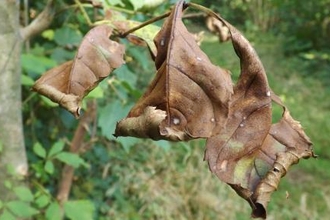Tree diseases are an increasing problem in the UK. In the past, the arrival of a new tree disease was a rare thing but, possibly because of increases in international trade and climate change, new diseases are arriving at an accelerating rate.
A key disease today is ash die back, caused by a fungal disease called Chalara. This entered the country a few years ago, probably from Europe, perhaps originating in the far east.
Our long-term strategy must be to build forest ecosystems that are resilient to disease in general.
Ash die back is now affecting the southern half of the country and is quickly spreading north. Ash is genetically diverse, so there is the possibility of resistance building up in the ash population. However, it could be that over 95% of our ash trees will be affected - there is a genuine concern that we may be seeing the end of ash as a common tree in the UK.
Our long-term strategy must be to build forest ecosystems that are resilient to disease in general. This could work at four levels – landscape, site, stand and tree scale.
We need connected landscapes with a diversity of forest types, at a diversity of scales, alongside rich and diverse woods, with a range of species. When planting individual trees, we will need to pay more attention to where we source material and the individual species choices we make. Building forest ecosystems using these four levels may be a good long-term strategy for resilience, but the scale of ash tree death now presents immediate problems.
Disturbance in woodland is a normal part of forest ecology, and this includes tree diseases. Retention of dead and dying trees provides habitat and falling trees in a wood creates open and scrubby habitat that has its own value. Leaving stands alone might also some enable resistant trees to appear.
Ash die back, however, presents special problems. It is difficult to fell and made more unpredictable when suffering from die-back and follow-on honey fungus infection. There are now many situations where a high level of management intervention is justifiable. Wildlife Trust staff, members and the public should be ready to see management activity in woods as a result of ash die back.
Clearly each case will need to be judged according to the local situation. Minimal intervention may still be the best approach in some places, especially where the dangers are limited and where management is difficult. Large areas, however, will require major landscape management and this will impact most on the most visible areas as these are the ones with most public access. It is likely that a zoned approach will be required, woods zoned according to the management required or possible.
Longer term we need a discussion on what should now replace past ash woods? Should we attempt to regenerate ash, allow natural species change (probably to sycamore), plant new species (native or non-native), or (in recent ash woods rather than ancient woods) use the change to create rich grassland and scrub habitat?
One thing is for certain. The problem of ash die-back is only just beginning, and we will all need to rise to the challenge very quickly.



